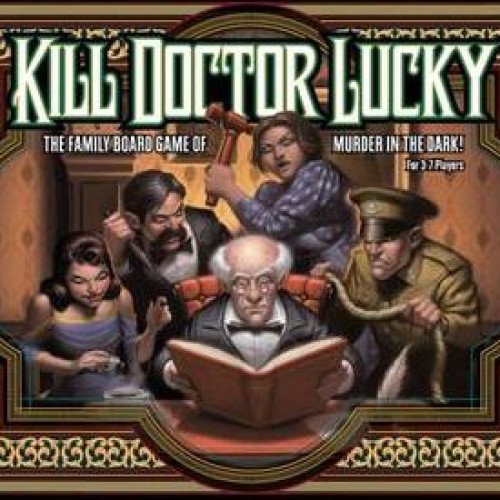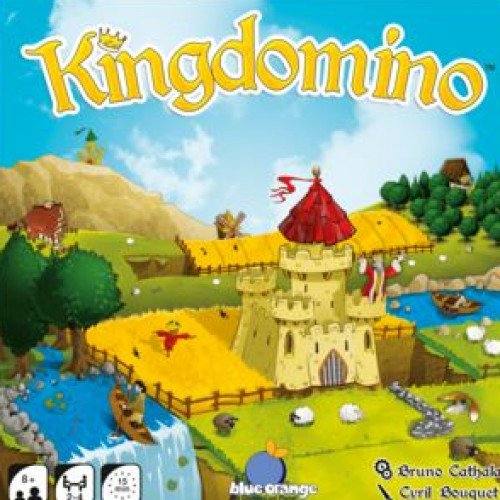"KILL DOCTOR LUCKY" vs "KINGDOMINO"

KILL DOCTOR LUCKY
Kill Doctor Lucky is a humorous board game designed by James Ernest and released in 1996 by Cheapass Games. In 1998, Kill Doctor Lucky won the Origins Award for Best Abstract Board Game of 1997. Kill Doctor Lucky is, in concept, a sort of inversion and perhaps a parody of Cluedo (Clue in North America). Both games are set in a sprawling mansion full of colorfully named rooms, feature a variety of dangerous weapons, and deal with the murder of the mansion's owner. Cluedo begins after the murder has been committed, and players compete to solve it; Kill Doctor Lucky ends with the murder, and players compete to commit it. In October 2015 a "Deluxe 19.5th Anniversary Edition" with new art and updated game mechanics was launched on Kickstarter. The gameboard is a floor plan of Doctor Lucky's mansion, and it is accompanied by a deck of cards representing the objects and opportunities that can be found there. Players take turns moving through the rooms of the mansion and accumulating cards, while Doctor Lucky moves through the mansion following a predetermined path. A player may attempt to kill Doctor Lucky by playing a weapon card (such as a runcible spoon, a monkey hand, a letter opener, a trowel, a chainsaw or pinking shears) while the player's token is in the same room as Doctor Lucky and out of sight of all other players. Each weapon card has a certain point value, and certain weapons are worth more points when used in certain rooms (for example, the trowel is worth extra points when used in the wine cellar, an allusion to Poe's "The Cask of Amontillado"). At this point, the player making the murder attempt succeeds, and thereby wins the game, unless the opponents play Failure cards of combined value equal to the value of the weapon used. The situation is complicated by the requirement that players play Failure cards in clockwise order, with each player having only one opportunity to play cards. Since it is to any player's advantage to eliminate failure cards from his opponents' hands, a large part of the strategy of the game consists in bluffing: when one player attacks Doctor Lucky, it is in your interest to persuade your other opponents that you have no failure cards in your hand, to attempt to force them to save the game by spending the required cards. When played, failure cards are set aside and not returned to the deck. Thus, as the game goes on, fewer and fewer failure cards are in play. This not only builds tension but also forces the game to end in a reasonable amount of time, because once all the failure cards are gone, the next murder attempt cannot fail. The new Titanic Games version of Kill Doctor Lucky makes two changes to the original rules. First, a minor change was made to game play that now allows everyone to take at least one turn before the Doctor Lucky pawn determines turn order. In the original, it was possible for players to position themselves in such a way as to keep some players from ever getting a turn. This is no longer possible.
Statistics for this Xoptio

KINGDOMINO
Kingdomino is a 2016 board game for 2-4 players designed by Bruno Cathala and published by Blue Orange Games. In this 15-20 minute, family-oriented game, players build a five by five kingdom of oversized domino-like tiles, making sure as they place each tile that one of its sides connects to a matching terrain type already in play. In 2017 Kingdomino won the Spiel des Jahres award for the best board game of the year. In the game players take turns choosing domino-like tiles and adding them to their kingdoms. Like traditional Dominoes, each tile has one or two different ends, which in this case also show different landscapes, and possibly a number of crowns on it. Choosing a tile with the most crowns gives a player last choice in the next round for choosing a tile, and vice versa - choosing the worst tile now ensures the first choice in the following round. When a tile is placed next to other tiles of the same landscape, they form a larger property. Each kingdom can be no larger than a 5x5 grid of landscapes. The game ends when the tiles run out, and then each property is scored based on how big it is, multiplied by the number of crowns in it. The player with the most points in all their properties wins. There is also a two player variant of the game which allows players to form a larger 7x7 grid of tiles. Kingdomino is considered by reviewers to be an accessible entry point into strategy board games, with its 15–20 minute playing time and its familiar game mechanics which bear similarity to Dominoes.